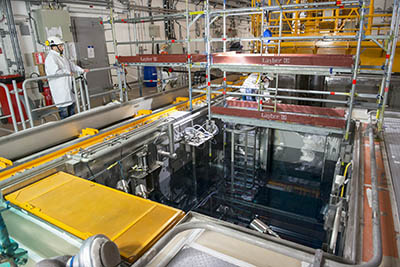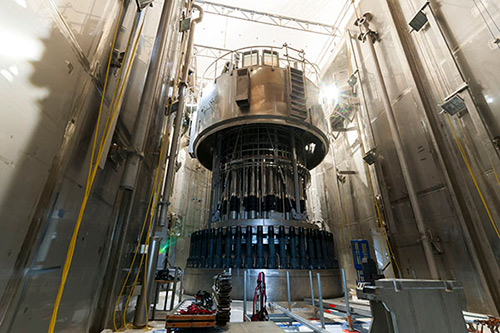Commissioning of a nuclear power plant follows a strict procedure
12.7.2017
As with all new nuclear power plants, the testing and commissioning of the Olkiluoto 3 EPR plant takes place according to the same, precisely specified procedure. The division of the process into main phases ensures that the plant unit and the organisation operating the unit are ready and tested before fuel is loaded in the reactor. The OL3 project also follows the same procedure.
Preparations for arrival of fuel under way
The fuel will be delivered to Olkiluoto in the autumn. A lot needs to be ready and approved before that. Fuel transports and fuel handling, for example, must be practiced. In 2016, a so-called dummy fuel assembly was delivered from Germany to Olkiluoto by road transport. The assembly was identical in dimensions and weight to the real fuel assembly, but the fuel rods of the dummy assembly did not contain uranium. After this transport exercise, tests related to fuel handling have been carried out by moving dummy assemblies underwater from the fuel building to the reactor pressure vessel and back.In March, the European Atomic Energy Community (Euratom) that controls the nuclear power industry and promotes research and technology in the nuclear power sector installed surveillance cameras at OL3. The installation work was supervised by the Finnish Radiation and Nuclear Safety Authority. Operational surveillance systems are a pre-condition for the delivery of fuel in the autumn of 2017 as scheduled. Euratom and the International Atomic Energy Agency IAEA use these systems to control that nuclear materials are not used for purposes other than those they are intended for.
Simulator training has started
OL3 operating staff is currently undergoing simulator training in two shifts. The simulator is a tool well-known to the operators since several years. A large amount of training has been provided, and every trainee has passed a written examination. This training period will complete the licensing training required of the operating personnel prior to fuel loading in 2018. The total training period is about one year long.A couple of hundred professionals busy in turbine building
The OL3 project has in the turbine building reached the de-preservation phase. The most visible work is the re-installation of the rotors of the low-pressure turbines. The rotors have been stored on the floor of the turbine building, covered with plastic, during preservation. This has protected them against moisture. De-preservation prepares the turbine island for hot functional tests, when steam is supplied to the turbines for the first time.
Cold functional testing in June, hot functional tests in autumn
Preparations have been made during the spring for plant-level cold and hot functional tests. The first phase of the cold functional test carried out in June was the pressure test designed for the verification of the leak-tightness of the primary circuit. The second phase consists of system tests simulating a situation where off-site power supply is lost. The required power is supplied with the emergency diesel generators.According to the schedule, hot functional tests will start in the autumn. This is an important milestone, as the plant's degree of completion needs to be quite high for these tests. The hot functional test is a pre-operational test where the OL3 plant is operated without the uranium fuel, but with the temperature and pressure of water in the primary circuit corresponding to production conditions. The testing is based on an extensive programme that will continue until the end of the year.
The primary circuit refers to the circulation of water between the reactor pressure vessel and the steam generator. The temperature of the water is increased to 328 degrees in the reactor pressure vessel, and the water is then lead in the reactor coolant piping to the steam generator, where heat is transferred from the water to the secondary circuit. The temperature of the water decreases to slightly less than 300 degrees, and the water returns to the reactor. A high pressure is maintained in the primary circuit to prevent the boiling of the water.
The loading of the fuel in the reactor will take place after the hot functional tests. The generation of the first kilowatt-hours at OL3 for the national grid will then be very close to becoming a reality. With everything going to plan, OL3 will produce 2–4 TWh of electricity at varying power levels in the latter half of 2018, i.e., 5–10 percent of the electricity consumption in Finland.

Text: Juha Poikola, Anna Saarenoja
Photos: Hannu Huovila
Share